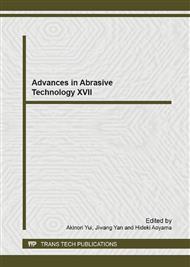p.544
p.549
p.553
p.559
p.565
p.573
p.580
p.586
p.592
Research on Performance of Fixed Abrasive Tools of Polishing 6H-SiC Wafers
Abstract:
6H-SiC single crystal substrates are considered to be suitable for thin film growth of semi-conductive GaN with wide energy bandgaps, because the lattice mismatch between 6H-SiC and GaN is quite small compared with sapphire substrates. However, the process of SiC wafer prior to epitaxial growth is quite difficult due to its high hardness and chemical stability. The chemical mechanical polishing (CMP) is typically performed in semiconductor device planarization, but the polishing slurry is not environmental friendly and the polishing efficiency is very low. In this paper, polishing experiments were conducted on 6H-SiC wafers using a flexible fixed abrasive film fabricated by sol-gel technique. Other three fixed abrasive tools bought from the different companies were also chosen in these experiments. Abrasive wear resistance on the different tools was observed with the increase of polishing time. Studies were also made on the surface micrographs and roughness of the 6H-SiC wafers polished by the four different tools in order to evaluate the tool performance. The results indicated that poor wear resistance of abrasive were showed in tool C and D, less abrasive worn out in the sol-gel polishing film and tool B. The surface quality of 6H-SiC wafer polished by the sol-gel polishing film was much better than the other three tools, and it attained the lowest surface roughness Ra=0.003 μm. Keywords: Sol-Gel polishing film; Fixed abrasive tools; 6H-SiC wafers
Info:
Periodical:
Pages:
565-570
Citation:
Online since:
September 2014
Authors:
Keywords:
Price:
Сopyright:
© 2014 Trans Tech Publications Ltd. All Rights Reserved
Share:
Citation:


